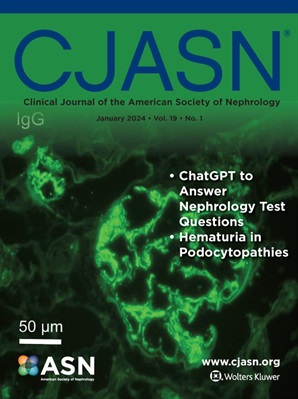Surrogate End Points in Apolipoprotein L1 - Associated Kidney Disease : Evaluation in Three Cohorts.
IF 8.5
1区 医学
Q1 UROLOGY & NEPHROLOGY
Clinical Journal of the American Society of Nephrology
Pub Date : 2025-01-01
Epub Date: 2024-11-05
DOI:10.2215/CJN.0000000000000575
引用次数: 0
APOL1 相关肾病的替代终点:三个队列的评估
背景:美国食品和药物管理局已接受肾衰竭临床结局的替代终点。然而,这些替代终点尚未在载脂蛋白 L1(APOL1)相关肾病中进行专门评估:这项随机效应荟萃分析包括社区动脉粥样硬化风险(ARIC)研究(N=3071)、慢性肾功能不全队列(CRIC;N=998)和非裔美国人肾脏病和高血压研究(AASK;N=609)中的非裔美国人参与者。替代终点包括肾小球滤过率(GFR)三年下降 30% 和 40%、尿蛋白与肌酐比值(UPCR)翻倍以及 GFR 每年下降 >3 ml/min/1.73 m2。临床结果包括需要肾脏替代治疗的肾衰竭、心力衰竭、心血管疾病和三年后死亡。结果:AASK、CRIC 和 ARIC 中分别有 22%、18% 和 13% 的人具有 APOL1 高危基因型。具有 APOL1 高危基因型的参与者三年后出现所有 GFR 结果的风险都较高,但 UPCR 没有翻倍,三年后出现肾衰竭的风险也较高。三年后的结果与肾衰竭密切相关,与心力衰竭、心血管疾病和死亡率的关系较弱,但在统计学上有显著意义。APOL1风险状况对短期和长期临床结果的影响没有差异:结论:与 APOL1 低风险基因型的个体相比,APOL1 高风险基因型的个体更容易出现三年 GFR 相关终点和长期肾衰竭。APOL1基因型与短期临床结果之间没有一致的差异,这支持在APOL1相关肾病中使用替代物。
本文章由计算机程序翻译,如有差异,请以英文原文为准。
求助全文
约1分钟内获得全文
求助全文
来源期刊
CiteScore
12.20
自引率
3.10%
发文量
514
审稿时长
3-6 weeks
期刊介绍:
The Clinical Journal of the American Society of Nephrology strives to establish itself as the foremost authority in communicating and influencing advances in clinical nephrology by (1) swiftly and effectively disseminating pivotal developments in clinical and translational research in nephrology, encompassing innovations in research methods and care delivery; (2) providing context for these advances in relation to future research directions and patient care; and (3) becoming a key voice on issues with potential implications for the clinical practice of nephrology, particularly within the United States. Original manuscript topics cover a range of areas, including Acid/Base and Electrolyte Disorders, Acute Kidney Injury and ICU Nephrology, Chronic Kidney Disease, Clinical Nephrology, Cystic Kidney Disease, Diabetes and the Kidney, Genetics, Geriatric and Palliative Nephrology, Glomerular and Tubulointerstitial Diseases, Hypertension, Maintenance Dialysis, Mineral Metabolism, Nephrolithiasis, and Transplantation.

 求助内容:
求助内容: 应助结果提醒方式:
应助结果提醒方式:


